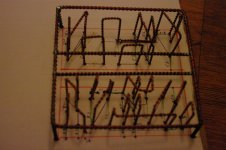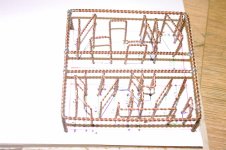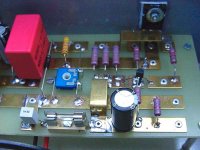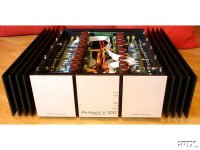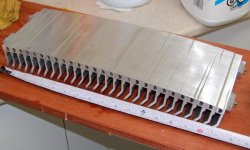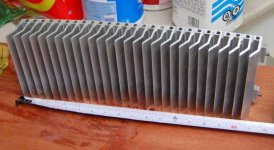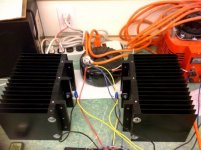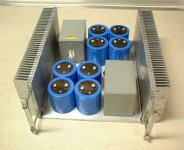Put that copper waste to good use! I look forward to seeing more of your 3D puzzle!
I just started reading Tony Kordyban's book 'Hot Air Rises and Heat Sinks' so hopefully I will come back with more solid heat transfer fundamentals...
I just started reading Tony Kordyban's book 'Hot Air Rises and Heat Sinks' so hopefully I will come back with more solid heat transfer fundamentals...
Wikipedia says it is a science fiction literary subgenre Steampunk - Wikipedia, the free encyclopedia
But I first heard the term when my son wanted me to help him build a steam punk computer. Way beyond my ability, but nice to look at.
https://www.google.com/search?q=ste...BG5Wl4AOCmIHQDg&ved=0CCsQsAQ&biw=1663&bih=867
So, Yes, it was a compliment.
But I first heard the term when my son wanted me to help him build a steam punk computer. Way beyond my ability, but nice to look at.
An externally hosted image should be here but it was not working when we last tested it.
https://www.google.com/search?q=ste...BG5Wl4AOCmIHQDg&ved=0CCsQsAQ&biw=1663&bih=867
So, Yes, it was a compliment.
Last edited:
i always put copper to good use 😉
steampunk, i think it will end up a bit like that.
looking at that desk and computer, i can hardly wait till i am finished. 😀
steampunk, i think it will end up a bit like that.
looking at that desk and computer, i can hardly wait till i am finished. 😀
For some reason (fake pcb?) it reminds me of this Zen revisited project in the Passdiy gallery.
The plumber left behind a roll of 16AWG solid copper wire, so I thought I would try something point-to-point one day...
The plumber left behind a roll of 16AWG solid copper wire, so I thought I would try something point-to-point one day...
Attachments
Interesting. Just remember that the tabs of the TO-220 need to be electrically isolated.
Or just keep them out of reach. Nichts gefingerpoken!
the plumber left a rol of copper wire, that is not something a plumper in holland would use, that is more the material of an electrician.
but stil, use it. point to point can be a work of art if done right.
what is in you picture is also beautiful, i wonder where the copper strip is coming from.
but stil, use it. point to point can be a work of art if done right.
what is in you picture is also beautiful, i wonder where the copper strip is coming from.
Or just keep them out of reach. Nichts gefingerpoken!
gefingerpoken???? i am learning more than just audio electronics here, but what is that? and what language? German?
It's pseudo-German.gefingerpoken???? i am learning more than just audio electronics here, but what is that? and what language? German?
Soldered fin is better than thermal paste for the interfaces.to answer ANDREWT no, there is no thermal paste, all parts are soldered together.
pseudo-wsedish, sounds like the cook on the muppets.
my son and daughter speak pseudo-bulgarian, also known in this house as gibberish.
my son and daughter speak pseudo-bulgarian, also known in this house as gibberish.
Relieved to see that the Dutchies got it figured out! As a semi-Swede myself, I always thought that chef sounded Norwegian...
OK, so I read this entire thread and thought I would collect all the 'log cabin' style heat sink pics here:
OK, so I read this entire thread and thought I would collect all the 'log cabin' style heat sink pics here:
Attachments
norwegian???? could be right to, i don't understand either swedish or norwegian, sorry.
getting back to the diy heatsinks, i like the style of the blue ones in the last picture.
relatively easy to make to. make that out of copper and i think it will be a little monster.
getting back to the diy heatsinks, i like the style of the blue ones in the last picture.
relatively easy to make to. make that out of copper and i think it will be a little monster.
best data for a newbie
Cool thread... ;-)
What I gained from reading it is that tall heatsinks are better heatsinks.
The original poster was looking for cheap so consider taller ones to save on material and if you don't have money you'll need a lot of patience.
For myself, I had to wait until I had a day off from work, in the middle of the week so I could travel to the recycler and that's after I found a recycler on the phone who would allow me to rummage through their bins of separated material. They cull out heat sinks from computers and other commercial electronics. I also found some huge corner brackets made of 10mm aluminum. I'll be attaching some 24# (10Kg) of those smaller heatsinks from smaller devices to those large corner brackets to form the basic structure of my Aleph J build.
Patience will be rewarded.
I will post pictures when I have made them look as pretty as I can, in the meantime anyone looking for cheap will have to start making phone calls...
Cool thread... ;-)
What I gained from reading it is that tall heatsinks are better heatsinks.
The original poster was looking for cheap so consider taller ones to save on material and if you don't have money you'll need a lot of patience.
For myself, I had to wait until I had a day off from work, in the middle of the week so I could travel to the recycler and that's after I found a recycler on the phone who would allow me to rummage through their bins of separated material. They cull out heat sinks from computers and other commercial electronics. I also found some huge corner brackets made of 10mm aluminum. I'll be attaching some 24# (10Kg) of those smaller heatsinks from smaller devices to those large corner brackets to form the basic structure of my Aleph J build.
Patience will be rewarded.
I will post pictures when I have made them look as pretty as I can, in the meantime anyone looking for cheap will have to start making phone calls...
I think you misread that, jdg. Wider heat sinks are more efficient, at least for extrusions. For example if your profile is rated at .5C/W at 3" tall, a 6" section will be on the order of .3C/W not the .25C/W that you might expect. Of course if you can't get the width you need to get the required dissipation go taller.
Many of the DIY heat sinks have conductivity issues across their width because of the joints in their assembly. This may be why you see that the DIY sinks do better taller.
Overall efficiency also depends on the heat distribution. If a single source and not enough base thickness taller might be more efficient. With multiple sources spaced out, wider is more efficient.
Many of the DIY heat sinks have conductivity issues across their width because of the joints in their assembly. This may be why you see that the DIY sinks do better taller.
Overall efficiency also depends on the heat distribution. If a single source and not enough base thickness taller might be more efficient. With multiple sources spaced out, wider is more efficient.
Last edited:
I was devastated at work this week. In the factory we use LOADS of Static Power Invertors which have absolutely MASSIVE heatsinks. They fail regularly and just get thrown away. During my hunt to find a supervisor to raise the required paperwork so that I could requisition a few from the skip, the skip lorry turned up. GUTTED.
Lesson to learn though. BIG heatsinks are often used in industry and can often be sourced as scrap for pennies.
Scrap CPU heatsinks from computers are good but it's often difficult to source enough that are the same in order to get a pleasing finished product.
Lesson to learn though. BIG heatsinks are often used in industry and can often be sourced as scrap for pennies.
Scrap CPU heatsinks from computers are good but it's often difficult to source enough that are the same in order to get a pleasing finished product.
Last edited:
This statement is generally considered to be incorrect 🙁 Taller than about 6" tends to loose effectiveness quickly. Longer is what you want. Try reading the data sheets from major heat sink mfgs. Fins mounted in the vertical direction up to about 150mm tall are the most effective. 200mm is a common maximum size and as tall as I have ever used. Some styles will dictate using 2 side by side which would be much more effective than 1 300-400mm tall heat sink. 😀...What I gained from reading it is that tall heatsinks are better heatsinks....
Edit: guess I wasn't quick enough at the draw...
- Status
- Not open for further replies.
- Home
- Amplifiers
- Pass Labs
- DIY heatsinks
